|

by Mike Wall
August 23,
2019
from
Space Website
Spanish similar
report
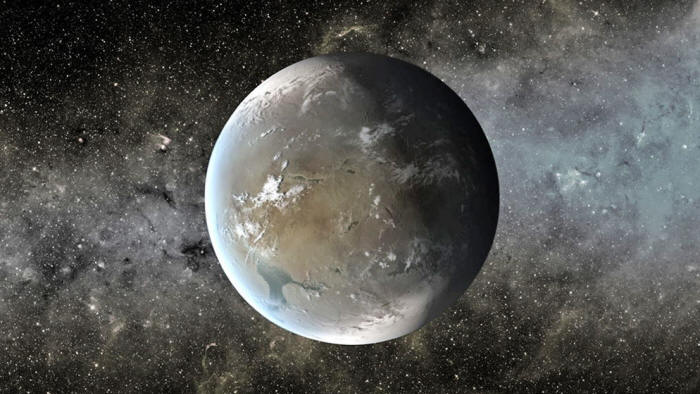
The artist's concept depicts
Kepler-62f,
a
super-Earth exoplanet in the habitable zone
of a
star smaller and cooler than the sun,
located
about 1,200 light-years from Earth
in the
constellation Lyra.
(Image: © NASA/Ames/JPL-Caltech)
We don't
have
optimum
ocean-circulation patterns,
it would seem...
Earth's dazzling biodiversity
may not be so remarkable in the cosmic scheme of things, a new study
suggests.
Alien planets
with more favorable ocean-circulation patterns might support life in
even greater abundance and variety than our own world does, the
study determined.
"Life in
Earth's oceans depends on upwelling (upward flow), which returns
nutrients from the dark depths of the ocean to the sunlit
portions of the ocean where photosynthetic life lives," study
leader Stephanie Olson, of the University of Chicago,
said in a statement.
"More upwelling
means more nutrient resupply, which means more biological
activity," added Olson, who presented the new research today
(Aug. 22) at the
Goldschmidt 2019 Conference in Barcelona, Spain.
"These are the
conditions we need to look for on exoplanets."
The new study
(Exo-oceanography
and the Search for Life in Uncharted Waters - below
image) provides a step in this direction.
Stephanie Olson
and her team used computer models to determine which types of alien
worlds have the most efficient ocean upwelling and are therefore
probably especially good places for life as we know it to thrive.
"We found that
higher atmospheric density, slower rotation rates and the
presence of continents all yield higher upwelling rates," Olson
said.
"A further
implication is that Earth might not be optimally habitable - and
life elsewhere may enjoy a planet that is even more hospitable
than our own," she added, describing this conclusion as
"surprising."
"We expect
oceans to be important in regulating some of the most compelling
remotely detectable signs of life on habitable worlds, but our
understanding of oceans beyond our solar system is currently
very rudimentary," Chris Reinhard, of the Georgia Institute of
Technology, said in the same statement.
"Dr. Olson's
work represents a significant and exciting step forward in our
understanding of exoplanet oceanography," added Reinhard, who
was not involved in the new study (below image).
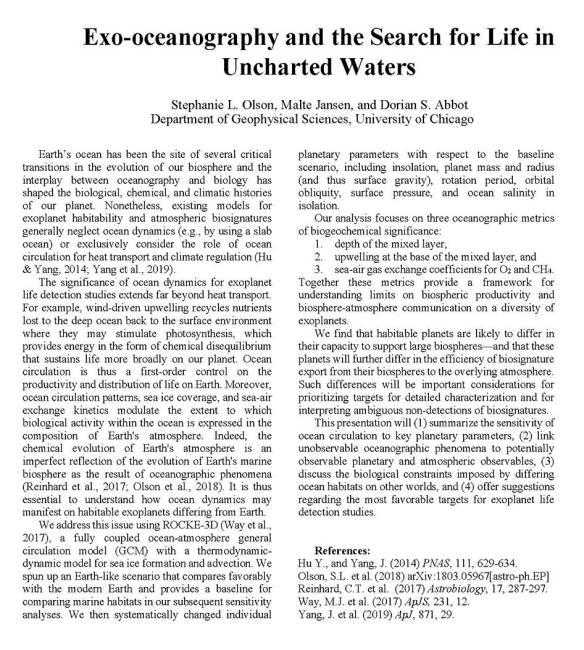
Source
Oceans are probably
incredibly common across the Milky Way galaxy.
After all,
observations by NASA's
Kepler space telescope and other instruments
suggest that about one in four stars hosts a potentially Earth-like
planet - a rocky world at the right orbital distance to host liquid
water on its surface.
And our own solar
system hosts multiple ocean worlds, though most of them are very
different from Earth.
Jupiter's moons,
...are all thought to harbor
big oceans of liquid water beneath their icy shells, for example, as
does Saturn's moon Enceladus.
The oceans of
Europa and
Enceladus are thought to be in contact with the moons'
rocky cores, making possible complex chemical reactions that may
well have led to life, scientists say.
Alien Life on Exoplanets
...may
be 'More Abundant and Active' than on Earth - Say Scientists
by Jamie Carter
August 22,
2019
from
Forbes Website
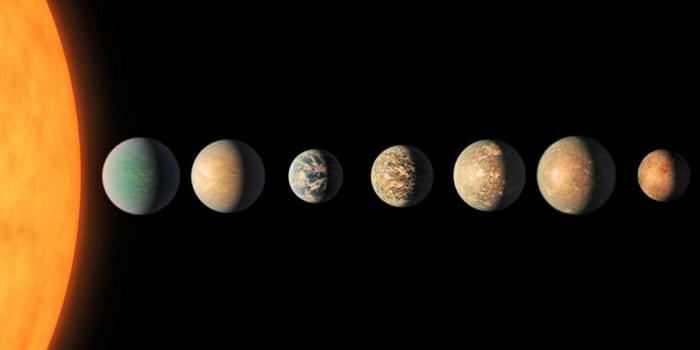
This artist's concept shows
what
the TRAPPIST-1 planetary system may look like,
based
on available data about
the
planets' diameters, masses and distances from the host star,
as of
February 2018.
3 of
the 7 exoplanets are in the "habitable zone".
NASA/JPL-Caltech
Earth is the only place we know of in the entire Universe
that sustains any kind of life.
That doesn't make it the
only place per se, and it certainly doesn't necessarily make it the
perfect place to support life. That's according to a
new study that
suggests that ocean currents may be critical in the search for life
beyond Earth.
The authors even suggest that Earth could be considered
sub-optimal, with distant
exoplanets much better suited to supporting life that's
both more abundant and more active.
"NASA's search for
life in the Universe is focused on so-called 'habitable zone'
planets, which are worlds that have the potential for liquid
water oceans," Dr. Stephanie Olson, T.C. Chamberlin Postdoctoral
Fellow at the University of Chicago, is expected to say on
August 23 at keynote lecture at the
Goldschmidt Geochemistry Congress in
Barcelona, Spain.
"But not all oceans
are equally hospitable - and some oceans will be better places
to live than others due to their global circulation patterns."
What do we know about
distant ocean-worlds?
Not much...
Astronomers'
understanding of oceanography beyond our solar system is presently
rudimentary.
During Exo-oceanography
and the search for life in uncharted waters,
Stephanie Olson - who studies
Earth history, ocean-atmosphere evolution and astrobiology - will
describe the search to identify the best environments for life on
exoplanets, with the study demonstrating that some exoplanets may
have greater variety of life than exists on Earth.
"This is a surprising
conclusion", says Olson.
"It shows us that
conditions on some exoplanets with favorable ocean circulation
patterns could be better suited to support life that is more
abundant or more active than life on Earth."
The key is the
sea
Olson's team modeled likely conditions on different types of
exoplanets using
ROCKE-3D software developed by
NASA's Goddard Institute for Space Studies (GISS).
They simulated the
climates and ocean habitats on different types of exoplanets, and
were able to define which exoplanet types stand the best chance of
developing and sustaining thriving biospheres.
"Our work has been
aimed at identifying the exoplanet oceans which have the
greatest capacity to host globally abundant and active life",
says Olson.
"Life in Earth's
oceans depends on upwelling - upward flow - which returns
nutrients from the dark depths of the ocean to the sunlit
portions of the ocean where photosynthetic life lives."
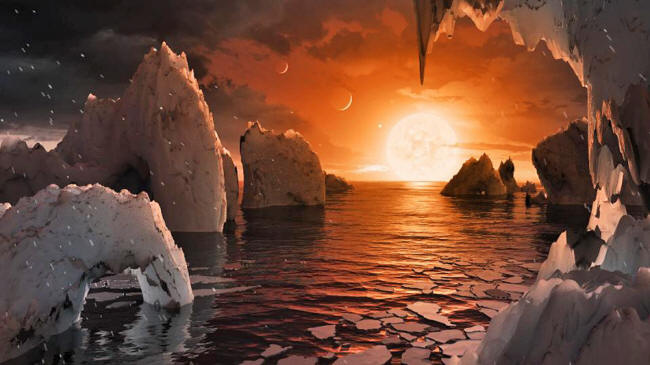
An artist's concept allows us to imagine
what it would be like to stand on the surface
of the exoplanet TRAPPIST-1f,
located
in the TRAPPIST-1 system
in the constellation Aquarius.
Because this planet is thought to be
tidally locked to its star.
2017 NASA
Why is ocean
circulation so important?
The process is pretty simple.
More upwelling means
more nutrient resupply, which means more biological activity.
"These are the
conditions we need to look for on exoplanets", says Olson.
"We have used an
ocean circulation model to
identify which planets will have the most efficient
upwelling and thus offer particularly hospitable oceans."
The study found that
higher atmospheric density, slower rotation rates, and the
presence of continents all yield higher upwelling rates.
However, perhaps the
most startling implication of the study is that Earth
might not be optimally habitable.
Life elsewhere may be
present on a planet that is even more hospitable than our own.
Why are 'exo-oceans'
important?
We can't visit exoplanets and search for life. Not us (for
now...), not robotic probes. They're just too far away.
So we point
telescopes at them in an effort to understand what conditions
prevail. To compare exoplanets - and to recognize which of them
may host life - scientists need sophisticated models of their
climates and evolution.
Though life may come in many forms and in many environments, we
only know for sure that life exists where a planet's temperature
allows liquid water oceans.
So in their search
for life on the 4,000+ exoplanets astronomers must target those
that will be most favorable to large, globally active
biospheres.
On these planets life
will be easiest to detect, and if it's not, then we'll learn
more about where to look next (and where not to).
How can we
check?
Future telescopes will use models like this one to search for
bio signs in the atmospheres of exoplanets.
"Ideally this
work this will inform telescope design to ensure that future
missions, such as the proposed
LUVOIR or
HabEx telescope concepts,
have the right capabilities", says Olson.
"Now we know what
to look for, so we need to start looking".
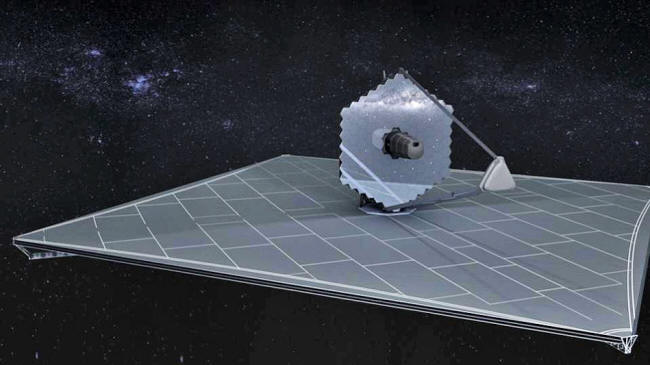
The
Large UV/Optical/IR Surveyor (LUVOIR)
is
a concept for a highly capable,
multi-wavelength space observatory
with ambitious science goals.
LUVOIR has the major goal of characterizing
a
wide range of exoplanets,
including those that might be.
NASA's Goddard Space Flight Center
Conceptual Image Lab
What is
LUVOIR?
Due to launch in 2039, the Large UV/Optical/IR Surveyor (LUVOIR)
will be a bit of an all-rounder, much like the Hubble Space
Telescope.
Using a 15-meter
mirror, it will likely be capable of studying exoplanet
atmospheres and searching for bio-signatures such as oxygen and
methane. It will even be able to directly photograph exoplanets.
What is
HabEx?
Now on the drawing board, the Habitable Exoplanet Observatory
(HabEx)
space telescope will directly photograph exoplanets despite them
being 10 million times dimmer than their host star.
That will be thanks
to a novel star-shade that will align itself many thousands of
miles away from the telescope to suppress the light from faint
stars of the exoplanets.
HabEx will also study
exoplanet atmospheres and look for signs of life.
|






